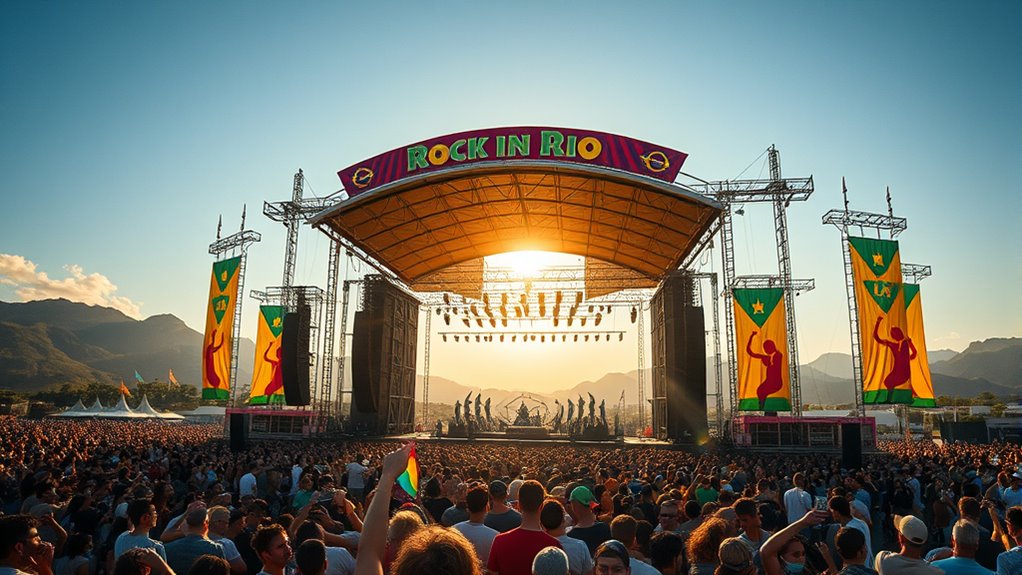Rock in Rio started in 1985 as a bold idea to bring together music lovers and showcase top artists from around the world. Inspired by legendary festivals like Woodstock, it aimed to highlight Brazil’s vibrant culture and elevate its presence on the global music scene. Organizing such a massive event involved complex logistics, securing permits, and attracting international stars. If you want to discover how it became a worldwide phenomenon, keep exploring this remarkable story.
Key Takeaways
- Inspired by iconic festivals like Woodstock, aiming to showcase Brazil’s music talent globally.
- Initiated in 1985 as a massive event in Rio de Janeiro, attracting over 1.5 million attendees.
- Faced logistical challenges, including securing permits, infrastructure, and attracting top international artists.
- Integrated cultural authenticity and advanced technology to create an immersive, memorable experience.
- Established as a global phenomenon, elevating Brazil’s reputation as a major music destination.

Rock in Rio started as a bold idea to unite music lovers and showcase top artists on a grand scale. The vision was to create a festival that would not only entertain but also elevate Brazil’s presence in the global music scene. Back then, the music industry was largely centered in the United States and Europe, leaving Latin America somewhat overlooked. The founders wanted to change that, and they saw a festival as the perfect platform to do so. From the start, the challenge was clear: organizing a massive event that could draw international stars and audiences while managing the logistical complexities involved. You need a well-thought-out festival organization that can handle everything from securing a suitable venue to coordinating with artists, sponsors, and local authorities. This meticulous planning was *essential* to turning a bold idea into a reality.
The initial concept was inspired by legendary festivals like Woodstock and Live Aid, but with a unique twist tailored to Brazil’s vibrant culture. The organizers aimed to create an event that would be both a musical celebration and a symbol of national pride. To do this, they brought together a team of experts who understood the nuances of festival organization and the intricacies of the music industry. They faced many hurdles early on—securing permits, attracting big-name artists, and building infrastructure in a short amount of time. Yet, despite these obstacles, they remained committed to their vision. Their efforts paid off when the first Rock in Rio took place in 1985, in a sprawling city park in Rio de Janeiro. It was a gamble, but it paid off, drawing over 1.5 million people across ten days and featuring some of the biggest names in music at the time. The event also showcased the importance of incorporating cultural authenticity into festival planning to resonate with local audiences. Additionally, understanding projector technology and its role in large-scale events like this can be crucial for creating immersive experiences.
The success of that first edition proved that Brazil could host a festival of this scale and significance. It also demonstrated how powerful effective festival organization can be in elevating a country’s status in the music industry. Rock in Rio quickly became a global phenomenon, inspiring subsequent editions in other countries and solidifying Brazil’s reputation as a music destination. The festival’s ability to bring together diverse genres, talented artists, and enthusiastic fans showed that music truly has the power to unite. If you look back, it’s clear that Rock in Rio’s origins were rooted in a bold vision, meticulous planning, and a deep passion for music—elements that continue to drive its success to this day.
Frequently Asked Questions
How Has Rock in Rio Evolved Over the Years?
You’ve seen Rock in Rio grow markedly over the years, transforming into a global festival. Its evolution includes expanding festival growth and increasing audience diversity, drawing fans from all over the world. You notice how it now features a mix of genres and artists, appealing to different age groups and cultures. This dynamic change keeps the festival fresh and exciting, cementing its place as a major event in the international music scene.
What Are the Most Iconic Performances in Rock in Rio History?
You’ll love knowing that over 700 artists have performed at Rock in Rio, making it a festival full of legendary artists. Some of the most iconic performances include Queen’s 1985 debut, Metallica’s unforgettable 2011 show, and Beyoncé’s 2013 headline. These festival highlights showcase the event’s evolution and its ability to host unforgettable moments, cementing its place as a global music phenomenon.
How Does Rock in Rio Impact Brazil’s Tourism Industry?
You’ll notice that Rock in Rio markedly boosts Brazil’s tourism industry through music tourism, attracting fans worldwide. This influx of visitors leads to an economic boost, benefiting local businesses, hotels, and airlines. As you attend, you contribute to the festival’s positive impact, helping Brazil solidify its reputation as a premier music destination. The event’s global appeal continues to draw diverse crowds, further enhancing the country’s cultural and economic landscape.
What Challenges Did Organizers Face During the Festival’s Inception?
Like building a house on shifting sands, you faced significant challenges during the festival’s inception. Logistical hurdles, such as coordinating massive crowds and securing venues, tested your planning skills. Financial constraints also posed hurdles, requiring creative fundraising and sponsorship efforts. These obstacles demanded resilience and innovation, ultimately shaping Rock in Rio into a world-renowned event. Your perseverance turned initial setbacks into a groundbreaking celebration that transformed Brazil’s music scene.
How Does Rock in Rio Promote Sustainability and Social Responsibility?
You see, Rock in Rio promotes sustainability through eco-friendly initiatives, like waste reduction and renewable energy use. It also prioritizes social responsibility by engaging in community outreach, supporting local charities, and fostering cultural inclusion. These efforts help minimize environmental impact and strengthen community bonds, making the festival not just a music event but a positive force for society. Your participation supports these initiatives, helping to create a sustainable, socially responsible celebration.
Conclusion
Now you see how Rock in Rio transformed Brazil into a global music hub. Like a spark igniting a wildfire, it sparked international recognition and inspired countless festivals worldwide. By bringing together diverse artists and fans, it created a vibrant cultural tapestry. So, next time you think of Brazil’s music scene, remember how this festival lit the way, proving that with passion and vision, you can turn a dream into a legendary reality.










